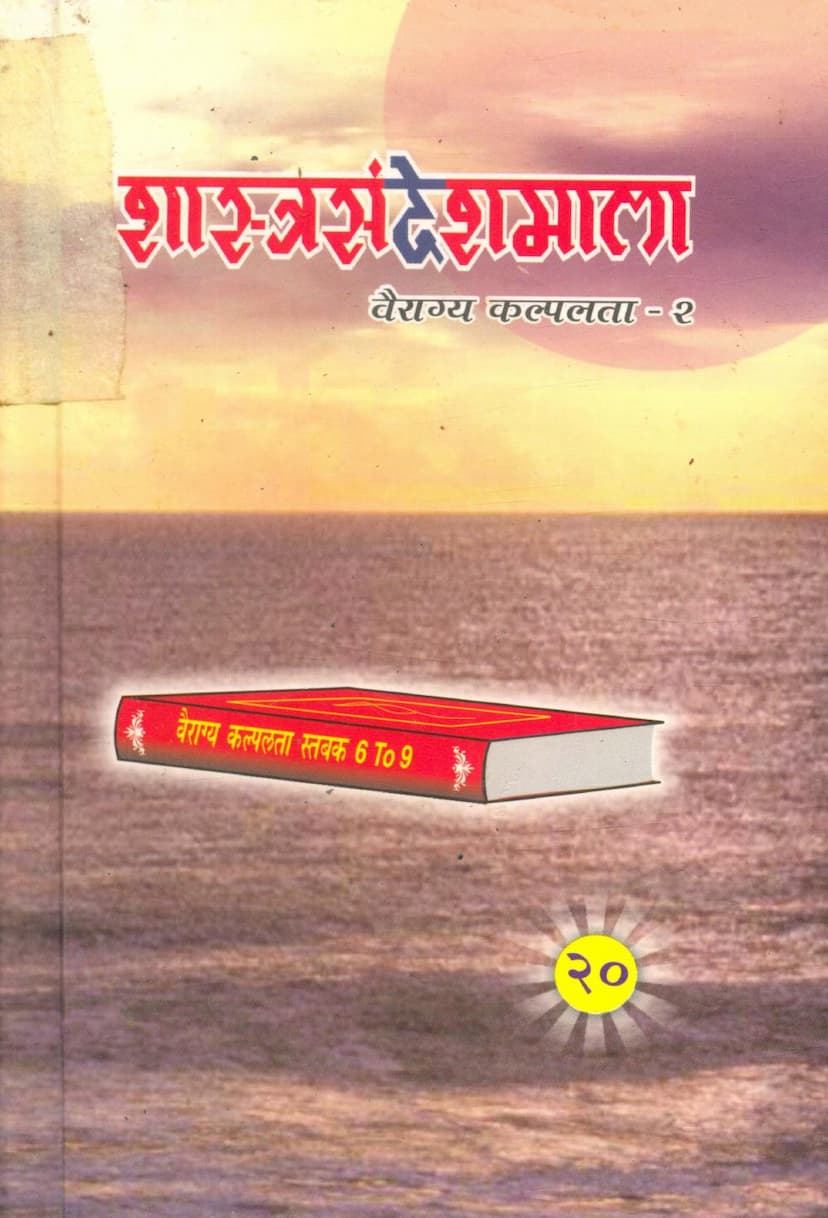Shastra Sandesh Mala Part 20
Added to library: September 2, 2025

Summary
This is a comprehensive summary of the Jain text "Shastra Sandesh Mala Part 20," authored by Vinayrakshitvijay and published by Shastra Sandesh Mala. The catalog link provided is https://jainqq.org/explore/004470/1.
The provided text primarily consists of introductory and publication details, followed by the beginning of the Jain text itself, "Vairagya Kalpalata" (The Wish-Fulfilling Creeper of Dispassion), specifically sections (Stabak) 6 through 9.
Key Information from the Introductory Pages:
- Book Title: Shastra Sandesh Mala Part 20
- Author: Vinayrakshitvijay
- Publisher: Shastra Sandesh Mala
- Compilation Credit: P.P. Aacharya Bhagwan Shri Mad Vijay Ramchandra Surishwarji's reign-influential Punyasi Bodhiratnavijayji M.Sa.'s disciple, Punya Muni Shri Vijayratnivijayji M.Sa. (This indicates the spiritual lineage and guidance behind the work.)
- Publication Location: Surat, Gujarat, India.
- First Edition: Released on Ashwin Vad 5, Vikram Samvat 2061 (corresponding to the Gregorian calendar year 2004).
- Price: ₹40/- (at cost price).
- Pramanjana (Review/Correction) Credit: Punya Muni Shri Hitarakshitvijayji M.Sa. and Panditya Shri Ratibhai Chimanalal Doshi.
- Type Setting & Printing: Pyal Printers, Radhanpur; Shriji Graphics, Paldi, Ahmedabad; Shivkrupa Offset Printers, Dudheshwar, Ahmedabad.
- Special Note: Volumes 1 to 20 of Shastra Sandesh Mala were published from "Gyanadravya" (knowledge fund).
- Inspiration and Sponsorship: The publication of the 20th part was inspired by Punya Muni Shri Hinkarprativijayji M.Sa. and sponsored by Shri Shantivan Sangh, Paldi, Ahmedabad from their "Gyanadravya Nidhi."
- Acknowledgements: Gratitude is expressed to various Jain institutions and their trustees/workers for their significant contribution in accessing over 400 rare Jain texts used in the 1-20 volumes. Specific institutions are listed, including Jain Upashrays and Poushadshelas in Radhanpur, Patan, Surat, Ahmedabad, and Kobha.
- Foreword/Editorial: It highlights the publication of over 400 chapters in verse by revered ancient scholars, totaling approximately 70,000 verses. The present publication is described as unique and beneficial. The compilation is attributed to Muni Shri Vinayrakshitvijayji M.Sa. under the guidance of Punyasi Shri Taporatnivijayji M.Sa. The 20 volumes include works by esteemed scholars like Aacharya Shri Haribhadrasurishwarji M.Sa. and Upashri Yashovijayji M.Sa., with the remaining volumes containing categorized works of various authors. Emphasis is placed on accuracy and purity in the publication, with specific revered monks and scholars involved in the review process.
Content of the Jain Text (Vairagya Kalpalata, Stabak 6-9):
The text then transitions into the actual Jain literature, starting with the Stabak (Section) 6 of Vairagya Kalpalata.
- Stabak 6: Begins with a poetic description of the city of Vardhamanpur and its inhabitants. It introduces King Dhaval and his queen Kamal Sundari, and their son Vimal. It also mentions the wealthy merchant Somdev, his wife Kanak Sundari, and the birth of a son named Vamdev (the narrator, implied). The narrative follows Vamdev's early life, including interactions with past life friends, the concept of reincarnation, and encounters in different life stages and locations. It details the birth of Vamdev in a royal family and his philosophical outlook even in childhood. The story touches upon themes of friendship, past karma, and the intricacies of life experiences.
- Subsequent Stabaks (7-9): The provided excerpt continues the narrative, detailing Vamdev's interactions with his friend Vimal, their exploration of a garden, encountering divine beings, and the subsequent events that unfold. The narrative progresses through various dramatic occurrences, including battles, encounters with supernatural elements, and the unfolding of past life connections and destinies. The text delves into the lives of characters like Ratnachud, Maya, and their intricate relationships and conflicts, all within the framework of Jain philosophy and ethical teachings. The stories often revolve around karma, dharma, and the consequences of actions.
Overall Theme:
The text "Shastra Sandesh Mala Part 20" appears to be a collection of Jain religious and philosophical works, with a strong emphasis on Vairagya (dispassion/renunciation) as depicted in "Vairagya Kalpalata." The narrative style is poetic and philosophical, illustrating principles of Jainism through stories and allegories, likely aiming to guide readers towards spiritual understanding and practice. The introductory material underscores the importance of preserving and disseminating Jain scriptures.